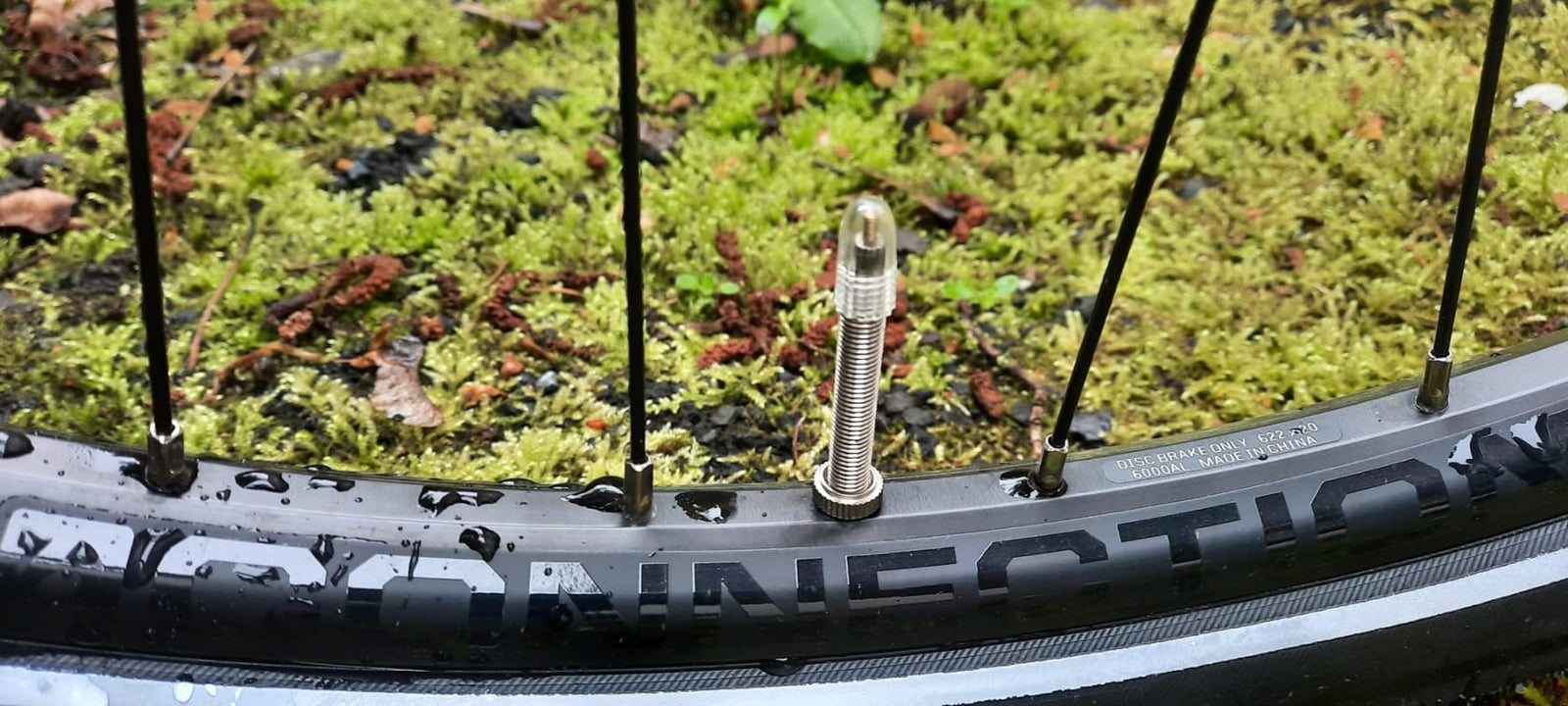Fahrradventile sind winzig – und trotzdem können sie dir jede Menge Kopfzerbrechen bescheren. Vor allem dann, wenn dein Reifen platt ist. Du hast vielleicht sogar einen neuen Schlauch am Start, aber, oh je… das Ventil passt nicht durch die Bohrung der Felge. Auch ein häufiges Problem: Der Kopf der Pumpe passt nicht auf das Ventil an deinem Fahrrad. Damit dir das nicht passiert, findest du in diesem Teil unserer Reifen-Serie alles, was du zum Fahrradventil und den unterschiedlichen, gängigen Ventil-Arten auf dem Markt wissen musst und wie du dazu die passende Luftpumpe kaufst.
Was ist ein Fahrradventil denn überhaupt?
Mal ganz von Anfang an: In deinen Fahrradschläuchen ist Luft. Damit man sie aufpumpen kann, braucht jeder Fahrradschlauch ein Ventil. Der sichtbare Teil des Ventils ist ein kleines Röhrchen aus Metall, das in den Fahrradschlauch eingepasst ist, die Verbindung wird vulkanisiert, damit sie hält und dicht ist. Dieses Metall-Röhrchen ist der Ventilschaft, er kommt in unterschiedlichen Längen, Formen und Durchmessern daher, aus diesem Grund gibt es unterschiedliche Fahrradventile. Im Ventilschaft steckt das eigentliche Ventil.
Das Fahrradventil ist ein Rückschlagventil, die Luft kann mithilfe einer Fahrradpumpe hineingepumpt werden. Wenn genügend Druck auf dem Reifen ist, verschließt das Ventil und die Luft kann nicht wieder entweichen.
Ab hier wird es etwas komplizierter, denn an Fahrrädern findest du unterschiedliche Ventile.
Welches Ventil hat mein Fahrrad?
Welches Ventil der Schlauch haben kann, hängt von den Felgen deines Fahrrads ab. Die Felge hat eine Bohrung, und durch die muss das Ventil passen. Es gibt hier zwei mögliche Varianten:
- Die Bohrung in der Felge hat 6,5mm Durchmesser. Dann passt ein französisches Ventil.
- Die Bohrung ist 8,5mm groß, dann passen Autoventil und Dunlop-Ventil.
> Wenn du neue Felgen oder Laufräder kaufst, findest du in den Spezifikationen in der Regel eine Größenangabe in mm oder dort steht ausdrücklich, welches Ventil passt.
> Wenn du ein komplettes Bike vor dir hast, und nicht weißt was passt, kannst du dir das Ventil ansehen und einfach vergleichen. Die drei gängigen Fahrradventile sehen unterschiedlich aus, du kannst mit etwas Übung sofort erkennen, welches an deinem Fahrrad vorhanden ist.
> Wenn du nur eine Felge (ohne einen alten Schlauch mit Ventil) hast, kannst du auch einfach die Bohrung nachmessen.

Du kannst Fahrradventile auch mit angewinkeltem Ventilschaft kaufen. Das erleichtert bei besonders kleinen Rädern, bei Kinderfahrrädern oder Schubkarren etwa, das Aufpumpen. Darum haben vor allem Schläuche in kleinen Größen, also in 12 Zoll oder 14 Zoll abgewinkelte Ventile.
Welche Fahrradventil Arten gibt es?
Am Fahrrad gibt es vor allem drei Ventiltypen: Schrader, Presta und Dunlop.
Wie so oft, wenn es um Fahrradteile geht, gibt es leider keine einheitliche Bezeichnung. Hier eine kleine Tabelle mit alternativen Bezeichnungen für die unterschiedlichen Fahrradventile und den wichtigsten Unterschiedungsmerkmalen:
Ventil |
Presta Ventil |
Schrader Ventil |
Dunlop Ventil |
|
weitere Bezeichnungen |
Sclaverand-Ventil, Französisches Ventil, Rennradventil |
Autoventil, MTB-Ventil, Motorrad-Ventil |
Normalventil, Fahrradventil, Blitzventil |
|
Abkürzung für das Fahrradventil |
SV, RV |
AV |
DV |
|
Durchmesser Felgenbohrung |
6,5mm |
8,5mm |
8,5mm |
|
erlaubter Druck (auch abhängig von Modell und Hersteller!) |
15 bar |
10 bar |
6 bar |
|
Welches Fahrrad? |
häufig am Rennrad und MTB |
oft am Mountainbike verbaut |
an Alltagsrädern wie Citybikes, Trekkingbikes und Kinderfahrrädern, an älteren Fahhrädern |
Das Dunlop-Fahrradventil
Das Dunlop-Ventil, Fahrradventil oder Blitzventil ist am Fahrrad sehr häufig anzutreffen, es ist millionenfach verbaut und erprobt. Schläuche mit Fahrradventil lassen sich sehr einfach befüllen, das ist ihr großer Vorteil, zumal auch die meisten handelsüblichen Fahrradpumpen passen. Das Innenleben eines Dunlop-Ventils kann außerdem ohne Werkzeug getauscht werden, wenn es undicht wird. Um einen neuen Schlauch einzuziehen, musst du zunächst die Überwurfmutter und den Ventileinsatz entfernen, das Ventil durch die Felgenbohrung stecken und anschließend beides wieder festschrauben. Allerdings liegt hier der maximal erlaubte Druck bei nur 6 bar, für die meisten Alltags-Bikes und Trekking-Fahrräder ist das aber ausreichend. Die Bauweise erlaubt es nicht, den im Schlauch befindlichen Druck genau zu messen.

Die Vorteile des Dunlop-Ventils:
- unkompliziert in der Handhabung
- stabile Bauweise
- weit verbreitet und mit den meisten Pumpen kompatibel
Der Nachteil:
- hier kann der Luftdruck nicht genau gemessen werden
- niedriger erlaubter Luftdruck
Das Schrader-Ventil
Wie der Name schon sagt, ist das Auto-Ventil oder Schrader-Ventil nicht nur am Fahrrad zu finden, es hält auch Autoreifen dicht. Das ist auch der größte Vorteil dieses Ventils: Du kannst einen Fahrradreifen mit Auto/Schrader-Ventil einfach “auf der Tanke” am Kompressor aufpumpen. Du musst also keine Fahrradpumpe mitschleppen, wenn du im Zweifelsfall bereit bist, dein Bike bis zur nächsten Tankstelle zu schieben. Aus diesem Grund ist es häufig an Tourenrädern und Reiserädern zu finden.
Ein Autoventil hat 8mm Durchmesser und passt in eine 8,5mm Felgenbohrung, es hält einen Druck von bis zu 10 bar aus. Um das Ventil zu öffnen, also um die Luft abzulassen, brauchst du einen schmalen Gegenstand, damit kannst du den Ventilstift drücken. Schraderventile lassen sich hin und wieder nicht mit einfachen oder älteren Fahrradpumpen aufpumpen.

Vorteile des Schrader-Ventils:
- Aufpumpen an der Tankstelle ohne weiteres möglich
- einfache Handhabung
- stabile Bauweise
- maximaler Druck von 10 bar
Nachteile des Schrader-Ventils:
- einige (ältere) Fahrradpumpen sind nicht kompatibel
- um das Ventil im Ventilschaft auszutauschen, brauchst du ein Spezialwerkzeug
Wie wird ein Auto- oder Fahrradventil montiert und aufgepumpt?
Die Montage dieser beiden Ventile ist denkbar einfach:
- Bei beiden entfernst die Überwurfmutter, beim Fahrradventil/Dunlop-Ventil auch das eigentliche Ventil aus dem Ventilschaft.
- Dann kannst du das Ventil durch die Felgenbohrung schieben.
- Anschließend wird beides wieder aufgeschraubt, wobei die Felgenmutter nur mit den Fingern leicht angeschraubt wird.
- Auf keinen Fall sollte sie mit einem Werkzeug fest angezogen werden, sie soll nur verhindern, dass das Ventil dir beim Aufpumpen in die Felge rutscht.
- Jetzt kannst du die passende Fahrradpumpe ansetzen und pumpen.
Das französische Ventil
Das französische Ventil wird auch als Presta-Fahrradventil, Rennrad-Ventil oder Sclaverand Ventil bezeichnet.
Es ist mit einem Durchmesser von 6mm schmaler als die anderen Fahrradventile und damit besonders gut für schmale Laufräder, also Rennradreifen, geeignet. Auch Mountainbikes werden immer häufiger mit Presta-, oder Sclaverand-Ventil gefahren, denn die kleinere Bohrung beeinträchtigt die Stabilität der Felgen weniger. Diese Fahrradventile vertragen mit bis zu 15 bar einen sehr hohen Reifendruck, daher werden sie traditionell am Rennrad gefahren. Da der Ventilstößel außerhalb des Ventils liegt, kann er einfach eingedrückt werden, um Luft abzulassen. Wenn du das kleine Rad an der Spitze des Ventils nach dem Aufpumpen festziehst, besteht andererseits nicht die Gefahr, dass du unabsichtlich Druck ablässt. Es ist – und das hört sich nicht weltbewegend an, wird aber am Rennrad immer gerne gesehen – bis zu 5 Gramm leichter als entsprechende andere Ventile. Der Luftdruck kann hier mit einer Pumpe mit Manometer sehr genau dosiert werden.

Die Vorteile des französischen Ventils:
- durch die kleinere Bohrung wird die Felge weniger geschwächt
- erlauben einen hohen Reifendruck
- der Reifendruck kann ohne Werkzeug oder Pumpe gesenkt werden
- ein paar Gramm leichter als andere Ventile
- Luftdruck genau einstellbar
Die Nachteile des französischen Ventils:
- der Stößel an der Spitze des Ventils ist recht dünn, er kann sich relativ leicht verbiegen, beim Abnehmen der Pumpe beispielsweise
Wie pumpe ich mein Fahrrad mit Presta-Ventil auf?
Der Einbau erfolgt ähnlich wie bei den anderen Ventilen. Die Überwurfmutter muss abgeschraubt werden, dann kann das Ventil durch die Felgenbohrung geschoben werden. Anschließend wird die Überwurfmutter wieder aufgeschraubt und nicht zu fest angezogen.
Das Aufpumpen eines Schlauchs mit französischen Ventil erfordert ein paar Handgriffe mehr als bei anderen Ventilen:
- Schraube die Kappe vom Ventil.
- Schraube den kleinen Ring an der Spitze des Ventils ein paar Umdrehungen weit auf.
- Drücke zweimal kurz auf den Ventilstößel (die Spitze des Ventils), um ihn zu lockern. Wenn dein Reifen lange nicht aufgepumpt wurde, kann er etwas fester sitzen. Er löst sich aber meist mit wenig Druck. Dabei entweicht etwas Luft.
- Schiebe den Kopf der Pumpe so weit es geht auf das Fahrrad Ventil. Auch hier kann etwas Luft entweichen. Es ist wichtig, die Pumpe weit genug auf das Ventil deines Fahrrads zu schieben, andernfalls öffnet sich das Fahrradventil nicht und es kann keine Luft in den Schlauch gepumpt werden.
- Wenn die Pumpe einen Hebel hat, kannst du sie jetzt damit fixieren.
- Jetzt sitzt die Pumpe sicher auf dem Fahrradventil und du kannst deinen Reifen bis zum gewünschten Druck aufpumpen.
- Du kannst nun die Pumpe vom Ventil abziehen.
- Zum Schluss wird der Ring wieder festgeschraubt und die Kappe kommt wieder auf das Ventil.
Beim Aufpumpen eines Schlauchs mit französischen Ventil solltest du Folgendes beachten:
- Achte darauf, die Pumpe immer gerade und ohne sie zu verkanten auf das Ventil zu schieben.
- Wenn der Reifen sich nicht oder nur schwer aufpumpen lässt, hast du möglicherweise den Ventilstößel nicht weit genug aufgedreht.
- Auch wenn du die Pumpe vom Ventil abziehst, solltest du darauf achten, dass du sie nicht verkantest oder zu sehr bewegst. Die Spitze des Ventils ist recht filigran, sie kann verbiegen oder sogar abbrechen.
Welches Ventil muss ein Fahrradschlauch haben, damit er passt?
Wie kaufst du den Schlauch mit dem passenden Ventil? Das ist gar nicht so kompliziert.
Du musst wissen, wie groß die Ventilöffnung deiner Felgen ist, dann weißt du auch, welches Ventil passt. In den Spezifikationen der Felgen sind 6,5mm oder 8,5mm angegeben, wobei 6,5mm nur für Presta-Ventile geeignet sind, in Felgen mit einer 8,5mm großen Bohrung passen alle Schläuche.
Wenn du in eine Felge mit einer großen Bohrung einen Schlauch mit einem schmalen Presta-Ventil einbauen möchtest, kannst du mit einer Ventilmutter oder Felgenmutter verhindern, dass das Ventil zu lose sitzt. Das ist aber eher eine Notlösung, und es wird davon abgeraten, ein schmales Ventil in Felgen mit großer Bohrung zu verwenden, denn bei dieser Kombi kann die Bohrung den Schlauch beschädigen.
Außerdem ist die Ventillänge wichtig. Hier kommt es auf die Höhe deiner Felgen an, denn das Ventil muss natürlich weit genug aus der Felge herausragen, damit die Fahrradpumpe greifen kann. Wenn das Ventil zu kurz ist, kannst du eine Ventil-Verlängerung einbauen.
|
Bei neuen Schläuchen ist die Art des Ventils und die Länge immer auf der Verpackung und in den Produktspezifikationen angegeben. |

Hier kannst du das Ventil bestens erkennen, so kaufst du den richtigen Schlauch. Bild © Tubolito
Wann brauche ich einen Fahrrad Ventil-Adapter?
Es gibt rund um das Fahrradventil unterschiedliche Adapter und Zubehör. Du kannst mit einer Ventilverlängerung die Länge des Ventils an die Felgenwand anpassen oder mit der Ventil- oder Überwurfmutter das Ventil befestigen. Hier einige der wichtigsten Zubehörteile für Fahrradventile:
Die Ventilverlängerung
Du kannst Fahrradschläuche in unterschiedlichen Ventillängen kaufen, es gibt Ventile mit 48mm oder 36mm Länge, aber auch 60mm oder sogar 80mm Ventillänge sind erhältlich. Für besonders hohe Felgen ist das aber nicht ausreichend. Viele Rennradfelgen, insbesondere Aero-Felgen, haben eine besonders hohe Felgenwand. Ein reguläres Fahrradventil ist für solche Hochprofil-Felgen in zu kurz, das heißt, es schaut nicht genug Ventil aus der Felge, um den Reifen aufpumpen. In diesem Fall kannst du Schläuche mit einem besonders langen Ventil suchen oder eine Ventilverlängerung anbauen.

Die Ventilverlängerung erleichtert das Aufpumpen bei besonders hohen Felgen. Bild © Birzmann
Der Ventileinsatz
Wenn dein Fahrradventil undicht ist, kannst du den Schlauch weiter fahren, nachdem du den Ventileinsatz ausgetauscht hast. Bei einem Presta-Ventil mit verbogenem Ventilstößel kannst du ebenfalls den Ventilkern austauschen.
Die Felgenmutter
Die Felgenmutter, Überwurfmutter oder Ventilmutter fixiert das Ventil in der Felgenbohrung. Wenn du einen neuen oder frisch geflickten leeren Schlauch einbauen willst, ist das sehr hilfreich, denn so kann dir der Schlauch nicht wegrutschen, wenn du die Pumpe ansetzt.
Die Ventilkappe
Bei neuen Schläuchen steckt auf dem Ventil eine Ventilkappe, du solltest sie nach dem Aufpumpen wieder aufschrauben. Wenn sie fehlt, ist das kein Drama, aber gerade das feine französische Ventil wird durch die Kappe gut geschützt. Auch die anderen Ventile sammeln unter der Kappe weniger Schmutz. Wichtig ist der Deckel aber insbesondere auf Ersatzschläuchen! Hier gibt es tatsächlich Berichte von Ventilen, die sich durch den darum gewickelten Schlauch gebohrt haben, und Bikern, die dann ratlos mit kaputtem Ersatzschlauch in der Wildnis standen.
Der Pumpenadapter
Der Adapter für die Fahrradpumpe ist nicht direkt Zubehör für ein Fahrradventil, gehört aber unbedingt mit in unsere Liste! Da viele Fahrradpumpen nicht auf alle drei Ventilarten passen, kannst du Adapter kaufen, die in die Luftpumpe eingebaut werden.
Es gibt außerdem Adapter, die es ermöglichen, alle drei Ventilarten an der Tankstelle zu aufzupumpen.

Wenn deine Pumpe nicht mit allen Ventilen kompatibel ist, kannst du Pumpenköpfe nachkaufen oder einen Adapter anbauen. Bild © SKS
Der gefürchtete Ventilabriss
Ein Fahrradventil, das plötzlich abreißt … klingt nicht schön und passiert glücklicherweise auch nicht allzu oft. Wenn das Ventil nicht gerade in der Ventilbohrung der Felge sitzt, kann es unter Druck irgendwann abreißen. Der Grund dafür kann ein unsachgemäßer Einbau sein. Der Schlauch kann aber auch “wandern”; das passiert, wenn die Überwurfmutter vergessen wurde.
Auch ein Presta-Ventil in einer großen Bohrung verabschiedet sich unter Umständen auf diese Weise.
Meist ploppt das Ventil aber nicht komplett ab, es reißt an, die Luft entweicht dann je nach Größe des Schadens mehr oder weniger plötzlich. In diesem Fall hilft nur eines: Raus mit dem restlichen Schlauch. Schau dir die Ventilbohrung deiner Felge an. Ist sie sehr scharfkantig? Dann kann sie vielleicht entschärft werden. Dann musst du einen neuen Schlauch einziehen.
Wie finde ich die passende Fahrradpumpe zu meinem Ventil?
Der Pumpendurchmesser für Presta-Ventile und Dunlop-Ventile ist gleich, eine Pumpe passt daher auf beide Ventile.
Standpumpen haben häufig zwei Öffnungen, dann passt das kleinere Loch auf französische Ventile und Fahrradventile (Dunlop), über die größere Öffnung kannst du Autoventile aufpumpen.
Minipumpen oder Handpumpen passen oft nur für ein Ventil, es gibt aber auch Modelle, bei denen der Dichtgummi im Pumpenkopf gedreht werden kann und damit verschiedene Durchmesser abdeckt.
Vor allem bei französischen Ventilen wird eine Pumpe mit Arretierung (also einem Feststellhebel) empfohlen, damit die Pumpe hält und das Ventil nicht beschädigt wird.
Autoventile kannst du mit einer entsprechenden Standpumpe oder Handpumpe aufpusten, du kannst aber auch mit deinem Fahrrad an die Tankstelle fahren und dort den Kompressor benutzen. Für die beiden anderen Ventile gibt es Adapter. Für den hohen Druck, der auf Rennradreifen gepumpt wird, sind die 5 bis 7 bar, die ein Tankstellenkompressor schafft, oft nicht ausreichend!
Welches Fahrradventil ist denn nun das beste für dein Fahrrad?
Wenn du ein Rennrad fährst, ist ein französisches Ventil meist die einzige Option, die meisten der schmalen Felgen haben eine kleine Bohrung, damit ist die Frage auch schon beantwortet. Am Gravel Bike sieht es ähnlich aus.
Am MTB hast du die Wahl. Willst du die größere Stabilität der Felgen mit kleiner Bohrung, also ein Sclaverand = französisches Ventil? Oder willst du den stabilen Ventilschaft eines Autoventils und die Möglichkeit an der Tankstelle zu pumpen?
Weil sie robust und unkompliziert sind, sind Fahrradventile (also Blitzventile oder Dunlop) oft am Citybike, an Kinderfahrrädern und Trekkingbikes anzutreffen.
Wenn du viel unterwegs bist, ist ein Autoventil recht praktisch, denn damit kann an jeder Tankstelle nachgepumpt werden. Daher werden Autoventile gerne bei Trekkingrädern und Reiserädern, aber auch an Alltagsbikes wie Citybikes montiert.
Es gibt hier also keine pauschale Antwort, jedes Ventil hat seine Vorteile und Nachteile.
Die Blog-Serie, die dir alles verrät, was du über Fahrradreifen wissen musst:





